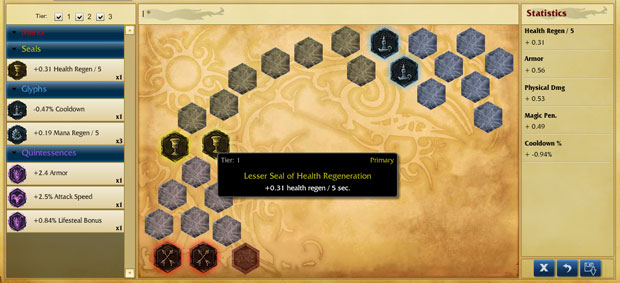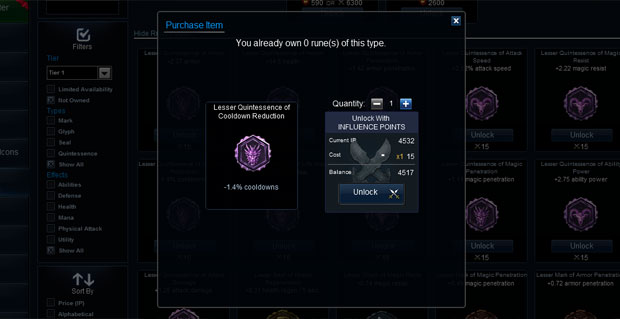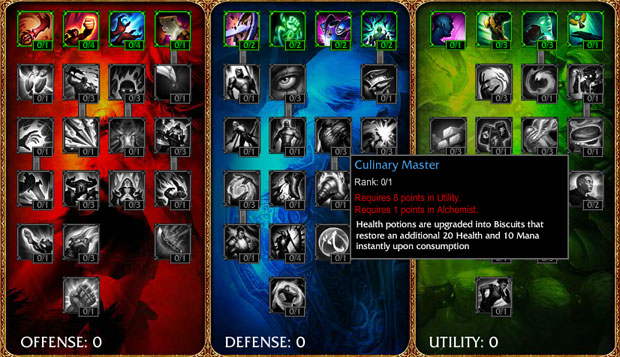Dote Night: Runes And Masteries With Riv
Rune for your life
Part of a miscellany of serious thoughts, animal gifs, and anecdotage from the realm of MOBAs/hero brawlers/lane-pushers/ARTS/tactical wizard-em-ups. One day Pip might even tell you the story of how she bumped into Na’Vi’s Dendi at a dessert buffet cart. THIS WEEK, however, she will be glaring at the runes and masteries of League of Legends!
In a few minutes of downtime at the recent MSI event League of Legends expert and caster Rivington "RivingtonThe3rd" Bisland III sat with me for a beginner-friendly Q&A focusing on Runes and Masteries. Both are ways to give a little boost to your Champions which you set up before a game starts. Runes provide little bonuses which you can stack in order to increase their effect. You put the runes into pages in order to set up slightly different builds, then pick one of these pages to use when you go into a match depending on how you want to play. Masteries are similar but rather than you just selecting the bonuses you fancy and plugging them into vacant spots you'll need to follow a progression tree, adding points strategically in order to access particular bonuses further down the line.
"Overall they have a slight impact on the game but they can definitely make or break a situation where you both come down to about 10 HP and you're trying to win that battle," is how Riv sees runes.
At their most basic, runes divide into four types – marks, glyphs, seals and quintessences. Marks are offensive, seals are defensive, glyphs deal with magic-related stats like spell cooldown and mana regeneration and quintessences offer utility. They're colour-coded red, yellow, blue and purple/gold respectively. You can also get runes which offer several effects but they'll have a primary option. Matching the outline colour of the rune with the spot you place it in means you get the primary benefits which are usually better, if you match the colour slot with the secondary benefits those can be significantly lower although still useful if you want a hyperfocused rune page.
Once you've started to fumble your way towards a build, one of the questions you might have is about flat runes versus per-level ones. Per level runes are also called scaling runes as their benefits grow as the Champion levels up meaning they're more effective in the later stages of a game while flat runes give you the same benefit throughout the game meaning their impact is felt in the early stages and then falls off.
"If you want to trade early usually you want flat because it will give you stats right away," says Riv. "If you go for scaling stats you get a little bit less at first then you have more at the end. So if you know you're going to be skirmishing right away – you're going to be a rush down champion and in your opponent's face – flat all the way. Flat armour, flat magic resistance and damage. Just don't expect to explode late game."
The quintessences are beefy runes which occupy the three big spaces on a rune page and tend to offer bigger bonuses in terms of power and stats. "You really need to fill the quints mostly with your damage," says Riv. "That's what you'll [usually] find there whether it's ability or attack power. Sometimes you'll see some HP in there or movement speed for junglers - there's a lot you can put in your runes that will them complement the items in your game."
The idea of complementing your item choices is a significant part of using runes effectively. In the example Riv gives, say you have 10% cooldown reduction just through your rune page alone – that means you only need to build items that give an extra 30% of cooldown reduction before you hit the game's 40% cap. That means you can focus on another stat or benefit with your item building earlier. Runes give you these nice little benefits, but they also give you wiggle room and inventory options.
I should confess I didn't touch the rune pages until relatively far into playing League but didn't think I was losing noticeably more often than after I started tinkering. Are runes particularly important, then? "We've had pros in the past actually forget runes and it does make the game a little more difficult," says Riv. "But if it's not a mix up by the computer system you kinda have to play with it. It does make it harder but you can still win without runes."
When you start playing you'll unlock rune slots as you level up your summoner profile, right up until level 30. It's a system of progression which means you can dip into runes without being particularly overwhelmed at first but, ultimately, with so many runes at your disposal the pages can get a touch unruly. Riv recommends keeping an eye on your own playstyle and picking the runes which augment what you like to do in a game.
"When you're leveling your champion in the first place and getting used to the game you'll see what you like," he says. "If you want to sit back and poke a bit mana regen and cooldown will be more efficient. Cooldown a lot of times also means more damage. Some of the mages will focus cooldown not damage because that's the way they get it out."
That's one of the more basic errors or assumptions – you have a mage so you amp up the magic damage. If your power comes largely from the spells you cast then by going for cooldown reduction and mana regeneration it means you should be able to get those spells off more often and increase the amount of damage you do by increasing the number of spells you cast rather than the damage of each individual spell. In a fight it could be the difference between getting off a single spell with slightly augmented damage versus double the damage by casting one spell twice.
If you want to see what runes the pro players are building, you can go to the player builds section of the match analysis page and take a look. Riv advises against taking these wholesale, though.
"A lot of times someone like Saintvicious [a former pro player who now coaches Team Coast] would get people coming on his streams and saying 'How do you build this?' and he didn't want to tell them straight up because that's how he plays it." Riv likens the situation to admiring a professional musician – you can look at what they do and try to figure out how it works but ultimately you'll have your own style. "You should never just try to replicate something. Nobody's ever going to be Faker even though we can all try."
That said, he's not exactly without guilt on that front thanks to a rune page Taipei Assassins' jungler Lilballz made for a champion called Olaf.
"I took his Olaf page - it was the first one I ever used because I didn't know. In the end I modified it a little bit but damn did that page work well! It's awesome to see what the pros use. Last year we found out the junglers were using a crit rune for 1-2% crit chance." It's a tiny chance to do a lot of damage so the point in using it was that it didn't sacrifice much in the way of other stats and power but it did give you a tiny chance to turn a 1v1 encounter into a kill or at least force your opponent to return to base to heal.
Then we come to the masteries – those Offence, Defence and Utility trees which you fill out using points earned from taking your summoner profile to level 30. Unlocking the bigger benefits means putting points in at earlier levels, fulfilling certain requirements. For example, Martial Mastery on the Offence tree gives you +4 attack damage but to use that option you'll need to have at least 8 points in other options on the Offence tree and 3 points in a specific lower tier skill called Brute Force.
"You'll see a lot of supports going utility. Mid laners as well if they want to get the biscuits. They'll give you back mana and health." Biscuits come via an option called Culinary Master. To unlock it you need 8 points already in the Utility tree and 1 point specifically in a skill called Alchemist. Culinary Master converts your health potions into biscuits which offer additional mana and health instantly on consumption. Mastery points cap out at 30. As biscuits are 9 points down that Utility tree and big benefits tend to get unlocked around the 20/21 point mark on any tree one of the builds you'll commonly see is a 21-0-9 Mastery build – the focus here is on offence but you can also nibble the biscuits.
Another mastery you can see easily in-game and which has an obvious power to turn fights is Dangerous Game. "Somebody dies and you'll see the other health bar go up just a little bit. That's a mastery taken called Dangerous Game." As per the mastery page, Champion kills and assists restore 5% missing health and mana. "We've seen that small percentage save people from an ignite death or something like that."
The key to masteries is understanding that you very rarely want to be a Jack of all trades.
"You want to choose something, you don't want to just be an amalgamation of all the trees - you want to get that 21st point," says Riv. "Sometimes you'll see a 12-18-0 or 18-12-0 just because that's the way it works for a tank. They won't focus on the damage stats that come from [points at] 19/20/21, they'll focus on a bit of cooldown from the beginning of the attack tree, ability power or attack damage and then they'll go to the defensive tree. No real cooldowns for the tank there so they can stay out of the utility tree and just get whatever they get out of their items. Supports will go more for the utility tree, mana regen, cooldown and then their items complement that cooldown."
According to Riv, "Having masteries and knowing what they are is definitely pertinent to the game. They give more than the runes. Getting those mastery points - you get one every level [until 30] - use it when you get it, it's definitely helpful."




















